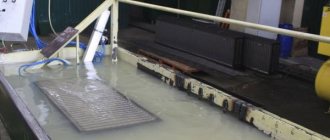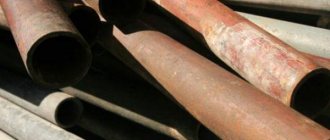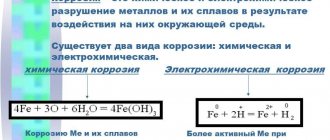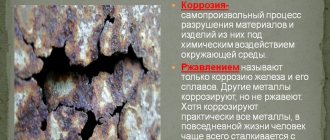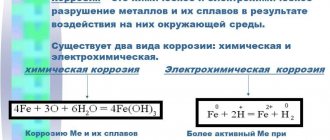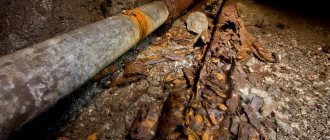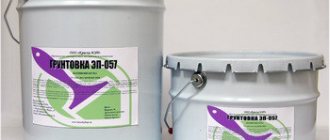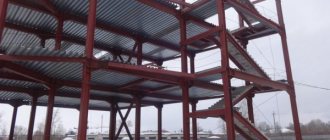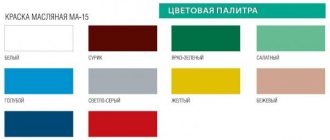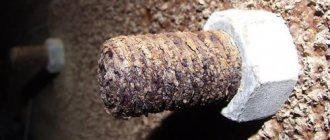Methods of protection against metal corrosion are relevant. Because metal is one of the most popular materials used in the automotive industry. And although it has been successfully replaced in some areas, the main problem associated with the use of metal products is corrosion. Types and methods of protecting metal corrosion differ from each other.
Corrosion, destruction of metal as a result of electrochemical action. This is the dissolution of an electrolyte or chemical action in a moisture-containing or airy environment, as a result of which metals combine with chemical elements located in an airy or aqueous environment. Rust is the corrosion of iron and its alloys; the corrosion of other metals comes down to oxidation, the formation of oxides. Chemical corrosion occurs as a result of exposure to dry gases and liquids that react chemically with the metal.
Types of metal corrosion:
- processes are chemical and electrochemical
-by the nature of destruction, uniform and not uniform
- by type of corrosive environment: gas, liquid, atmospheric, soil
Chemical corrosion
Based on the reaction between metal and an aggressive environment. The result of this corrosion is the formation of scale on the metal, or in the case of copper, a green coating. This type of corrosion spreads evenly over the entire surface of the metal. Chemical corrosion does not affect metal as strongly as electrochemical corrosion.
Electrochemical corrosion
This is a process in which metals and alloys lose some of their electrons, they pass into an electrolytic solution formed on the surface of the metal in the form of ions, and the electrons replacing the metal atoms pass into the metal with a negative charge, a galvanic reaction is formed, resulting in the destruction of the metal . Metals used in construction are usually subject to electrochemical corrosion due to the presence of moisture on the surface of the metal, this is caused by a constant change in temperature, resulting in the formation of condensation.
Atmospheric corrosion
Atmospheric corrosion of metal is similar to the occurrence of electrochemical corrosion, due to the presence of air humidity. When humidity rises above 70 percent, intense loss of steel occurs. The corrosion process is also affected by the presence of aggressive elements in the environment such as carbon dioxide, sulfur dioxide,
uniform across the surface , but it does not pose a great danger if it does not reach critical levels of metal damage. Uneven is the most dangerous because it can form separate areas of damage to the metal, which will lead to a significant weakening of the elements of the metal structure.
It is impossible to completely avoid corrosion processes, but it is possible to reduce the impact of these processes.
There are several types of corrosion control measures.
Specifics and standards
The distance from the cable to the gas pipeline, as well as other parameters that relate to the transportation of electricity through an electric cable and gas fuel through a gas pipeline, are provided for by special instructions for construction, operation and safety.
Electric cable
The rules for the design of electrical installations provide for a variety of difficulties and subtleties that may arise when placing electrical power panels. They can be group, external or internal.
It is impossible to answer the question of what distance should be maintained between the gas pipeline and the electric cable without taking into account the specific features of the engineering project, because the standards depend on several parameters in each specific case.
Laying high voltage cables underground
Recommendations have been made to the prescribed standards several times. This happened as isolation methods improved, transportation changed, and networks developed and branched out.
Electric cable in the ground
In the case of a pipeline, the distance is regulated according to separate principles. It all depends on the type and variety of the special structure, its technical equipment, the required level of pressure in the gas main, as well as the place and method of its installation:
- In SP 62.13330.2011 “Gas distribution systems”, supplemented and revised SNiP 42-01-2002 (attached to it is a table of minimum distances from gas pipelines, which organically follow from the safety standards and regulations specified in the code).
- The PB (FNiP) approved in 2013 provides for industrial safety features for those facilities that use hydrocarbon fuel in a liquefied state.
- The Decree of the Government of the Russian Federation, adopted on November 20, 2000 (No. 878), specifies the distances required to be maintained in public and residential buildings. The main function of this regulation is to prevent dangerous situations. They can arise due to incorrect placement of gas pipes in relation to other systems.
Laying electrical cables underground
Norms
The distance between the cable and the gas pipeline is also determined by the specifics of electricity transmission. Gas pipelines can be of underground and above-ground types, electricity can be transmitted through underground cable or overhead overhead lines. The distance from the communication cable in the airspace depends on the security zone of the power line, the power and operating mode of the electrical installation.
Overhead power line
In an underground cable network, everything depends on the voltage class and insulation safety, the proximity of other objects, their size and purpose. A safety zone is provided for power lines, the dimensions of which are marked in the form of a geometrically calculated polygon. The underground cable can be equipped with additional devices that make it possible to reduce the distance.
In addition to the Decree of the Government of the Russian Federation No. 169, which determines the procedure for installing security zones, rules for the design and provision of electricity transportation and the organization of safety measures, there is GOST 13109-97 “Electric energy”, GOST 14254-2015 “Degrees of protection provided by shells”, technical rules operation of consumer electrical installations (PTEEP) and SNiP 21-01-97 “Fire safety of buildings and structures”.
Corrugation
The rules for electrical installations have been repeatedly edited and adjusted. They are aimed at preventing possible violations due to non-compliance with distances. The Ministry of Energy regulations, for example, stipulate a minimum distance between sockets for electrical appliances and the gas pipe in the room.
It is set at 50 cm to prevent the possibility of household gas explosion if sparking occurs in the outlet. In other cases there are many nuances
Particular attention is paid to the distance from the cable to the above-ground or underground location of natural gas or energy transportation facilities
Medium pressure gas pipeline
Methods of protection against metal corrosion
Methods of protection against metal corrosion are divided into technological, active and passive.
Active methods
Methods of protection against corrosion of metals involve constant exposure to the metal, these include methods of changing the corrosive environment. This is a decrease in soil acidity, a decrease in chlorine content in water. Protective protection also belongs to the active method; it consists of binding the metal to a contact material that is more susceptible to oxidation, it is called a protector and is essentially a lightning rod. Takes over electrolysis processes that affect metal rusting.
Technological techniques
This is when, during the production of metal, chromium, titanium, manganese, and nickel are added to the steel alloy, which help to obtain steel with anti-corrosion properties. For example, when chromium is added, a high-density oxide film is formed on the metal surface.
Passive methods
The metal is insulated using various coatings that prevent the formation of corrosion. Cathodic and anodic coatings are used.
Anodic coating
When applying anodic coating, a metal is coated with another metal with a large negative potential. This is usually zinc or cadmium. Currently, it is common to protect metal by applying a layer of zinc.
Cathodic coating
produced by metals with a more positive potential. When cathodic coating of metal, mechanical protection of the metal is observed. Tin-copper is used as a cathode coating. nickel. To coat metal, the hot method, spraying, metallization, galvanization are used. With the hot method, steel is placed in molten metal, which is coated with a thin layer. The hot method is used for tinning, coating metal with tin, and galvanizing.
Oxidation
Chemical methods of coating the metal are also used, this is oxidation, an oxide film is formed that protects the metal from corrosion, this process is also called steel bluing. You can also treat steel with anodization, which is the electrolysis of aluminum. Also through phosphating and nitriding.
Application of enamels and primers
The most accessible method of protecting metal is the use of special enamels and primers.
They provide barrier protection from the effects of harmful environmental factors; it consists of mechanical protection of the surface. Damage to the coating occurs when microcracks form, resulting in under-film corrosion. To prevent this, passivation of the metal surface is carried out using special paint and varnish coatings.
The composition includes special chemical agents. Such paint and varnish coatings include primers and enamels containing phosphoric acid and other inhibitory elements that slow down the corrosion process. More effective paint and varnish materials are those that provide protective protection. This is achieved by adding metals that create donor electron pairs to paint coatings, these include zinc, magnesium and aluminum.
To protect metal structures that are operated in an industrial atmosphere, special enamels are being developed that form moisture-protecting urethane coatings. To protect against constant contact with an aqueous environment, enamels are produced that can be applied to zinc, copper and other surfaces.
Currently, a wide range of anti-corrosion enamels are available on the market. One of the innovations is the coating of metal with fluoroplastic; it is chemically inert to almost all aggressive environments. Enamels based on it are applied with a brush, air or airless spray, to a cleaned metal surface. When using a particular material, it is necessary to take into account factors such as the type of metal, the conditions of its operation, production capabilities and the feasibility of use.
Corrosion treatment agents are used depending on the type of metal, the operating environment, and the loads acting on it. For each area of operation of the structure, standards are provided. The optimal method is metal processing in a factory. That is, the application of transport primer.
Before he gets to the construction site. The application of anti-corrosion materials provides only 20 percent of metal protection; the main factor influencing the quality protection of metal is its pre-treatment from dirt. rust, as well as any other substances that will interfere with the painting of the surface.
Device
Anode grounding electrodes work as follows. When present in an electrolyte, various metals have excellent electrode potentials. Therefore, if you put “-” through the pipeline from a constant source of electricity, and in the immediate vicinity of the pipe place an electrode consisting of magnesium, aluminum or zinc, to which “+” is connected, then these metals, in relation to ordinary steel in the electrolyte, will perform the function anode.
This element, in this electrochemical system, will self-destruct in the soil, thereby protecting the cathode, that is, a gas pipeline or other communication pipe, from the effects of corrosion.
In a similar way, underground metal containers and other objects that are made of material susceptible to corrosion can be protected from destruction. In order to ensure the protection of underground metal objects at the proper level, it is necessary not only to select a high-quality anode grounding conductor, but also to carry out installation work correctly.
Metal corrosion treatment
Mechanical cleaning of the surface using brushes, scrapers, as well as using power tools with various attachments
Sandblasting is the most effective method for cleaning surfaces, but it has a number of disadvantages, such as low productivity, the creation of dust, which disrupts working conditions at the construction site.
Hydrojet cleaning increases productivity, and the use of abrasive materials improves cleaning quality.
Chemical cleaning . It involves the use of special materials that are divided into washable and indelible.
Rinse-off chemical cleaning methods
Washable materials include a 5% solution of hydrochloric or sulfuric acid, but when using these materials it is necessary to use a substance that slows down the chemical process, the so-called inhibitor. If you do not slow down the chemical reaction, in addition to rust, the metal itself will be destroyed. You can use a 15-30% solution of orthophosphoric acid; as a result of its use, rust turns into a solid structure, which is protection against subsequent corrosion. A mixture of 50 g of lactic acid per 100 ml of petroleum jelly helps well. Acid converts rust into salt, and petroleum jelly dissolves it.
Leave-in chemical cleaning methods
Consider the use of soil converters; rust is converted into soil and does not require further rinsing. If it is not possible to completely get rid of rust, it is necessary to pre-paint the metal using a primer with special anti-corrosion properties. Final surface treatment is carried out using varnishes, paints, and enamels with special properties.
Stages of anti-corrosion work
- Preparation of necessary materials.
- Applying a primer to ensure better adhesion of the enamels.
- Application of enamels with protective coating
- Drying the coating or heat treatment.
The most effective method of applying paint and varnish coatings is considered to be the airless spraying method. Since it allows for painting with the highest quality. Existing metal irregularities.
A less effective way is to paint with a brush. It is not advisable to apply paint coatings with a roller.
Quality control of work performed
The methods used to protect against metal corrosion are subject to quality control. Performed to verify previously performed production controls. Defect prevention. Development of measures to eliminate detected defects. Quality control of anti-corrosion work begins with checking the documentation. Documentation on the anti-corrosion protection facility, the materials used, and product quality certificates must be provided. Upon completion of the quality control of the work, a report is drawn up containing information about the location of the work, the state of the work performed, the materials of their grade and consumption used. Information about the organization that performed the work, and the signatures of the persons who carried out the work. The commission conducting quality control checks the following parameters:
— type of anti-corrosion coating, there should be no areas that have not been treated.
— the thickness of the coating layer is checked by measuring in various places where poor quality processing is presumably possible.
— the adhesion of the paint and varnish material to the metal surface is controlled.
Violations detected during quality control of work.
After completing the work, rusting occurs on the surface of the treated metal, this is due to the fact that the temperature regime was not observed or the moisture was not completely removed. It is also possible that the metal is not sufficiently cleaned of oxides, which leads to subsequent corrosion. Insufficiently removed various contaminants, oil, soap, salts, all this will lead to damage to the paintwork and further rusting of the metal. The presence of dust on the surface being treated reduces adhesion. Which leads to peeling of the paintwork. Failure to maintain the time allowed for the metal to remain untreated leads to its rusting; interlayer holding must also be observed; the solvent does not have time to dissolve and it leaks through other layers. Which leads to disruption of the coating in the form of bubbling. All these violations identified during quality control must be corrected immediately.
grounding
Power supply UNP2-7-65
The housings of the switchboard, UNP installation, compressor, and air heater are united by a common grounding wire, which is connected to a grounding bolt mounted on the car frame on the left side. This bolt must be connected to the s.
Air heater for UNP2-7-65
2. Check the ground connection to the control panel. 6.3. Open the control panel. Make sure there is no moisture or dirt inside the control panel and check the position of the handles of the RCD switches and the “Heating” automatic device: the RCD must be turned on (knob .
Installation of intra-shop pipelines
What are the minimum distances allowed between the axes of the pipes being laid? 4. Tell us about the rules for grounding pipelines to remove static electricity. .
